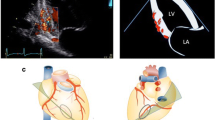Abstract
Transthoracic Doppler echocardiography offers a noninvasive approach for imaging posterior descending coronary artery (PD) running in the posterior longitudinal sulcus along the middle cardiac vein (MCV). To evaluate whether the MCV flow velocity reserve can reflect the PD flow reserve, 22 children with various heart diseases were examined using transthoracic Doppler echocardiography. Introduction of a modified transthoracic two chamber view with the transducer rotated counterclockwise and angulated posteriorly allows visualization of the MCV and PD. Peak systolic flow velocity and average peak systolic flow velocity in the MCV and peak diastolic flow velocity and average peak diastolic flow velocity in the PD were measured at rest and hyperemic conditions (intravenous administration of adenosine of 0.16 mg/kg/min). Coronary flow reserve was defined as the ratio of peak hyperemic to basal average peak flow velocity. ATP infusion induced significant increases in the peak systolic flow velocity and average peak systolic flow velocity in the MCV. The mean MCV flow velocity reserve in the patients was 1.94 ± 0.44. Significant increases in the peak diastolic flow velocity and the average peak diastolic flow velocity in the PD were also observed during ATP infusion, and the mean PD flow velocity reserve (2.19 ± 0.62) was significantly higher than the GCV flow velocity reserve (p < 0.0001).
There was a good correlation between the MCV flow velocity reserve and PD flow velocity reserve (r = 0.86, p < 0.0001). This study demonstrated that it was possible to measure the MCV flow velocity and MCV flow velocity reserve in pediatric patients by transthoracic Doppler echocardiography. The MCV flow reserve correlated highly with the PD flow reserve. However, the degree of the MCV flow during hyperemia was less than that of the PD flow. This underestimation should be considered when the reactive hyperemic response is evaluated from the MCV flow velocity.




Similar content being viewed by others
References
Aoki M, Harada K, Takada G (2003) Noninvasive visualization and measurement of posterior descending coronary artery flow velocity by transthoracic Doppler echocardiography in normal children. Am J Cardiol 91:376–379
Bland JM, Altman DG (1986) Statistical methods for assessing agreement between two methods of clinical measurements. Lancet 7:307–310
Ganz W, Tamura K, Marcus HS, Donoso R, Yoshida S, Swan HJC (1971) Measurement of coronary sinus blood flow by continuous thermodilution in man. Circulation 44:181–195
Harada K, Tamura M, Toyono M, Takada G (2001) Noninvasive visualization and measurement of great cardiac vein flow by transthoracic Doppler echocardiography in normal children. Am J Cardiol 88:710–713
Harada K, Tamura M, Toyono M, Takada G (2002) Transthoracic Doppler echocardiographic measurement of flow velocity and flow velocity reserve in the great cardiac vein and in the left anterior descending coronary artery in children with left ventricular volume overload secondary to ventricular septal defect. Am J Cardiol 89:1129–1133
Mito K, Ogasawara Y, Hiramatsu O, Tsujioka K, Kajiya F (1990) A laser Doppler catheter for monitoring both ohasic and mean coronary vein flow. Heart Vessels 6:1–8
Rossen JD, Oskarsson H, Stenberg RT, Braun P, Talman CL, Winniford MD (1992) Simultaneous measurement of coronary flow reserve by left anterior descending coronary artery Doppler and great cardiac vein thermodilution method. J Am Coll Cardiol 20:402–407
Tries H-P, Lambertz H, Lethen H (2002) Transthoracic echocardiographic visualization of coronary artery blood flow and assessment of coronary flow reserve in the right coronary artery: a first report of 3 patients. J Am Soc Echocardiogr 75:39–42
Ueno Y, Nakamura Y, Takashima H, Kinoshita M, Soma A (2002) Noninvasive assessment of coronary flow velocity and coronary flow velocity reserve in the right coronary artery by transthoracic Doppler echocardiography: comparison with intracoronary Doppler guidewire. J Am Soc Echocardiogr 75:1074–1089
Yamagishi M, Hotta D, Tamai J, Nakatani S, Miyatake K (1991) Validity of catheter-tip Doppler technique in assessment of coronary flow velocity and application of spectrum analysis method. Am J Cardiol 67:758–762
Voci P, Pizzuto F (2001) Imaging of the posterior descending coronary artery. The 1ast frontier in echocardiography. Ital Heart J 2:418–422
Author information
Authors and Affiliations
Corresponding author
Rights and permissions
About this article
Cite this article
Harada, K., Tamura, M. & Toyono, M. Noninvasive Visualization and Measurement of Middle Cardiac Vein Flow by Transthoracic Doppler Echocardiography. Pediatr Cardiol 27, 679–684 (2006). https://doi.org/10.1007/s00246-003-0651-8
Received:
Accepted:
Published:
Issue Date:
DOI: https://doi.org/10.1007/s00246-003-0651-8




